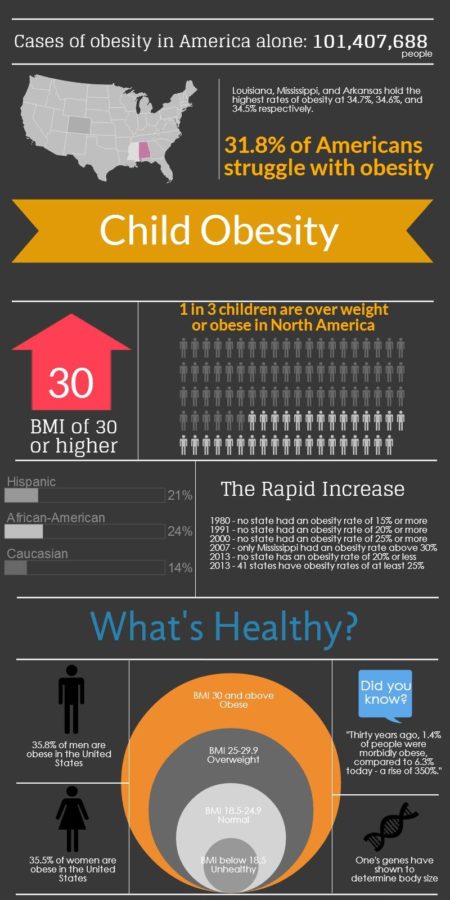American obesity rates rising to epidemic levels
America’s rate of obesity is at 31.8 percent as of July 2013, which is more than twice the rate in 1980, as reported by the Food and Agricultural Organization (FAO). This is equivalent to about 101,407,688 people in the United States.
One contributor to this outburst was the United States fast food restaurant boom in the 1970s. Currently the obesity rate across the world is continuing to rise.
“Obesity is a problem in all developed countries, but worse in the U.S. due to inactivity and long commutes. The electronic forms of entertainment creates more sedentary individuals,” health teacher Ann Peiler said.
Luckily, there are programs in place in the Orono community to keep students active.
“We have daily activities in which students are being physically active. We stress to the students to get their working heart rate to 60-70 percent of their max heart rate during the class period,” physical education teacher Barry Wohler said. “This allows the students to increase their fitness, gain energy and burn calories.”
Also, students have the opportunity to participate in sports and extracurricular clubs without them interfering class time because of the Spartan Hour schedule. Many clubs take advantage of this by holding meetings during Spartan Hour instead of after school when most sports teams practice.
“It’s not about the calories,” senior Mitchell Carlson said. “It’s about whether or not you burn off those calories by exercising.”
According to Jennifer B. Marks of the American Diabetes Association, “adults in the United States eat an average of 500-800 calories more per day than needed to maintain weight.”
An individual’s metabolism also plays a big role in one’s body mass index (BMI). The effects of poor eating and little exercise do not always affect ones size. Negative consequences like diabetes, heart disease, and high cholesterol can still become an issue in those who have a high metabolism.
“I know people who eat a lot and gain weight and people who eat a lot and don’t gain a pound,” senior Tommy Sellers said. Sellers recently wrote an essay on obesity in America for his senior Language and Composition class.
“Weight isn’t the ideal measure. Measuring body fat or body composition is a better measure but a more complicated method of determining risk for disease.” Peiler said. “For example, a healthy female adult should be around 14-20 percent body fat. A healthy male between 10-16 percent body fat.”
The official BMI measurement of someone who is obese is 30 percent according to the Mayo Clinic. Another factor feeding into the high obesity rates across the world is the economy. Lately, money has not gone as far as it used to because things cost more.
At fast food restaurants like McDonalds, it is easy to grab a meal for around $5 per person. While shopping at a grocery store, however, foods like fruits and vegetables are priced higher, especially during the off-season.
“25.4 percent of adults earning $50,000 per year or more are obese today, compared to 31 percent of people earning less than $25,000,” according to Sarah Muntel of the Obesity Action Coalition.
It is important for individuals to watch what he or she eats and should put one’s health above taste.
Senior and visual editor,Claire Mayhew, found her passion for journalism her junior year and has been a part of the staff ever since. "It was my older...











